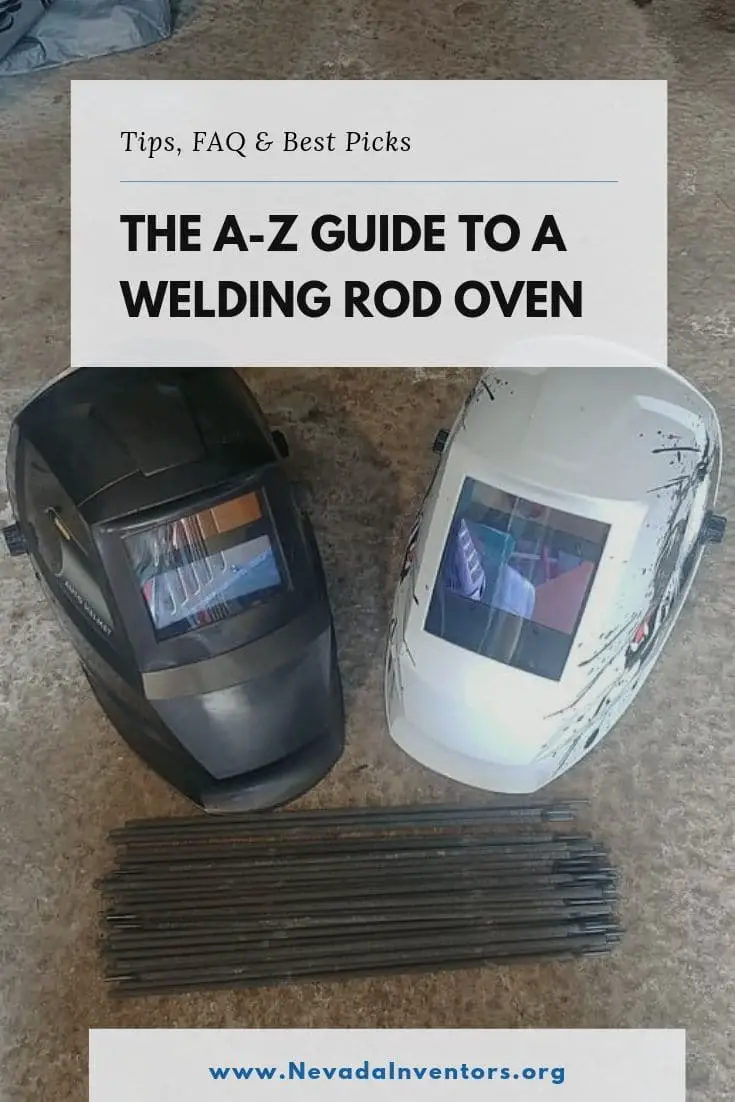We get a lot of reader inquiries asking us about various products — the good, the bad, and the ugly.
Recently Joe messaged us to ask about a welding rod oven we could recommend.
We already had some pretty good selections, but I thought it would be worth the time to investigate the latest and greatest and do a write-up for anyone else interested.
So Joe — and anyone else interested! — before you go wasting your hard-earned money, here are our selections for the Best 5 Welding Rod Ovens.
Joe’s Question
First of all — what is a welding rod oven?
Many of you probably already know, but we find a few people have never been formally introduced to the concept. Joe asked us recently:
I weld as a hobby, however, my colleagues are constantly asking me about storing my welding rods. Personally, I’ve never thought about this, because I don’t know if that’s critical or not. Tommy, please help me out with this.
Welding electrodes have flux coating.
When exposed to air, this coating can begin to absorb water from the air around it (hence why they come in hermetically sealed packages).
This moisture can transfer into the weld and weaken it, leading to cold breaks.
Additionally, Lo-Hy (low hydrogen) electrodes are designed to prevent hydrogen inclusion into the weld.
Lo-Hy rods that absorb hydrogen — through the air, moisture, etc. — stop being Lo-Hy and are no longer fit for purpose.
That’s why welding rod ovens are used. They bake the moisture out of the rod and allow the rod to be stored for use without moisture buildup. This keeps them in prime condition for the best results.
Note: If you’re a hobby welder, you don’t strictly need a welding rod oven. A sealed icebox can do the trick for most hobby work.
Welding rod ovens are for professionals or hobbyists who want to work to the highest possible standard.
We always recommend getting one, but don’t stress if you’re starting out and can’t afford one just yet. Save and use this guide in the future!

So, in order to answer Joe’s question, I spent a few hours (I stopped counting at 10) finding the best welding rod ovens on the market.
There were certainly some good ones, but in the end, I culled the list by about 80% to just the top 5.
How Did I Pick These Products?
I had five criteria when selecting these welding rod ovens:
BRAND: Yes, there’s the cliche of paying exuberant costs for a brand name, but that’s disingenuous.
Known, big-name brands typically have higher quality assurance tests than off-brand counterparts; they’re more sturdily built and typically last longer.
You could go and find a Chinese off-brand item of many of these. They might even be from the same factory.
But they won’t have passed all the QC checks needed to ensure functionality and safety.
That’s why I’ve stuck to reputable brands with good reputations.
RELIABILITY: These ovens aren’t necessarily cheap. They’re not horribly expensive, either, but they’re an investment and a substantial cash outlay.
You don’t want to be replacing it every few months or years, so the more long-lasting and reliable, the better.
PRICE: Like I said — not cheap, but not horribly expensive. You largely get what you pay for.
Trying to save money on a welding rod oven will often result in violating the above two points. It also means you’re often risking a less-safe product, which nobody wants.
The goal was to spend an appropriate amount of money, without necessarily breaking the bank.
SIZE: I wanted to make sure there was a good spread of sizes for welders of all experience levels and welders. There’s no point in creating a best-of list that only includes one size.
The goal is to be the five best, not the five identical!
Finally, there was a serious consideration to making sure the welding rod ovens were appropriate for all skill levels, from hobbyists to professionals.
Whatever stage of welding you’re at, you’ll find a welding rod oven in the list below to suit your needs.
A List Of 5 Rod Ovens I Suggest
Keen KT-15 Portable Welding Rod Oven
This handy, portable welding rod oven will store up to 15lbs of 18” electrodes.
The oven is ideal for Lo-Hy welding electrodes that need to be protected from moisture and hydrogen buildup to run optimally.
Being portable, this unit can be easily taken out into the field wherever you might need it.
From construction sites in the middle of nowhere to a hobby setup in your back yard, the Keen LT-15 will go where you need it to.
The item itself weighs just 13lbs, giving it a fully loaded weight of 25lbs. Even at full capacity, it’s not difficult to move the unit around.
The large square base will keep it plenty stable during use and storage as well.
As a portable unit, a longer power cable might have been nice — at just 8 feet in length, you’ll definitely need an extension cable out on the field.
TIP: The Keen KT-15 lid only has a latch on the lid. To keep the lid locked while storing rods, get a small padlock to make sure the latch doesn’t open.
The last thing you want is the lid creaking open while trying to bake your electrodes.
Lincoln Electric Hydroguard Portable Electrode Oven
Another great portable option.
The Lincoln Electric Hydroguard Portable Electrode oven has a lower storage capacity than the Keen KT-15 above, at just 10lbs compared to 15.
However, the overall unit is smaller and lighter and is a perfect on-the-go addition to any welding kit.
The lift design of the rod storage compartment makes it easy to retrieve baked rods.
As you lift the handle, the rods radiate outwards from the chamber, making it convenient to select one or more rods.
Made of 10 gauge steel and heating to 300F, the Lincoln Electric is the small, convenient electrode oven you’ve been looking for.
TIP: The small profile of this portable oven makes it perfect to sit in a corner of a workshop, before throwing on the back of a truck to take to a worksite.
Keen K-10L Portable Welding Rod Oven with Lid Latch
The Keen K-10L is a slightly smaller model than the Keen KT-15. It only holds 10lbs of 14” rods, instead of the 15lbs of 18” rods.
This makes it great for hobbyists or those who regularly use smaller electrodes in their work, and don’t need the larger units for storage.
The Keen K-10L itself weighs 10lbs, with a maximum loaded weight of 20lbs (unit plus rods).
It comes in the same distinct Keen blue color and features a flat square base for stability.
This oven is fast and energy efficient. It will reach a maximum operating temperature in under 10 seconds, without drawing much power to do so. As a portable unit, this is great — it gets to work quickly, and can be plugged into a generator without draining too much power.
Perhaps one drawback of the design is that, unlike the Lincoln Electric above, the inner storage chamber doesn’t lift out for convenient rod retrieval.
The rods will remain bunched up when you open the lid, so be careful extracting your electrodes.
TIP: If you’re needing to work quickly, don’t fill the unit to full capacity. This will make it easier to withdraw baked electrodes, especially when wearing gloves.
SÜA – Portable Electrode Drying Oven
This is the cheapest of the options so far, but by no means the worst. This model is lightweight and portable (have you noticed the theme?), storing up to 11lbs of 18” rods.
It’s perfect for hobbyists looking to get an electrode oven without spending $200-$1000 on the other models on the list.
Unlike the other models listed so far, this unit has an adjustable temperature depending on the power source you’re plugged into.
The range goes from 320F all the way up to 570F, if you’re plugged into 220-volt power.
At lower power consumption the 320F temperature is all that’s available, but this is what most of these ovens reach anyway.
It’s perfect for use in the field on a three-plug generator.
Like the Lincoln Electric, this features a convenient liftable rod storage platform that brings the rods to you when you open the lid.
This makes retrieving your rods all the easier after baking.
TIP: The thermometer is not entirely accurate, so make sure your rods don’t require absolutely specific temperatures to bake properly.
Consider the thermometer a ballpark figure.
Keen K-200 Bench Holding Rod Oven
Rounding out the list is yet another Keen model. This thing is definitely not portable.
It holds up to 200lbs of rods and, as the name says, is entirely intended to sit on a bench all day, every day.
The Keen K-200 is designed for small-medium-sized welding shops — or the hobbyist with a ridiculous budget.
Its unique rod storage shelving system induces natural convection for thorough heating. Even fully loaded, you can rest easy knowing each of your rods is getting adequately baked.
Despite its size and capacity, the Keen K-200 is energy-efficient and won’t blow out your power bill.
Its adjustable temperature ranges from 150F to 300F — and unlike the SUA above, is plenty accurate.
TIP: It might be too large to be portable, but the unloaded unit is light enough to be picked up by a single person.
Frequently Asked Questions
How hot should a welding rod oven be?
Ideally, you want your welding rod ovens to be between 250-350F for optimal performance.
Different rods sometimes need different temperatures — for example, Lo-Hy 7018 rods should be baked at around 250 for best results.
An oven that’s too hot will remove the flux coating, and an oven that’s not hot enough won’t adequately dry the rods.
All of the ovens listed above are set for the ideal temperature for baking most rods.
Why use a welding rod oven?
We touched on the “why” above with regard to moisture and keeping the rods free of hydrogen.
Hydrogen or moisture that settles into the flux coating will transfer into the weld puddle, resulting in a sub-optimal weld that is likely to break. Keeping the rods dry prevents this from happening — although there are other methods.
In terms of why using a welding rod oven specifically, a few reasons. You can use your at-home kitchen oven, but it’s certainly not recommended. Welding rod ovens are purpose-built and designed for this task in mind.
They do one thing, and one thing only — whereas your kitchen oven really isn’t designed to dry out welding electrodes!
There’s also the issue of portability. The portable options above let you work anywhere — but good luck taking your kitchen oven to a work site!
What is a welding rod oven?
A welding rod oven is a device used to store and bake welding electrodes. After opening the hermetically sealed package they come in, welding electrodes are exposed to air and can start absorbing water.
Welding rod ovens stop this happening and remove any moisture they might collect.
Welding rod ovens come in many shapes and sizes, from small portable units to industrial-sized behemoths.
They have different carrying capacities and temperatures for a variety of needs and uses.
From the enthusiastic hobbyist to a large welding workshop, there’s a welding rod oven to suit anyone’s needs.
Final Thoughts
Whether you weld in your spare time or do this for a living, I hope you’ll agree with the above options for welding rod ovens.
I steered clear of the big, industrial-sized units in favor of a list that suits people of all skill and passion levels.
From small and portable to slightly bigger bench units, I hope you’ll find the welding rod oven you were looking for somewhere up above.

